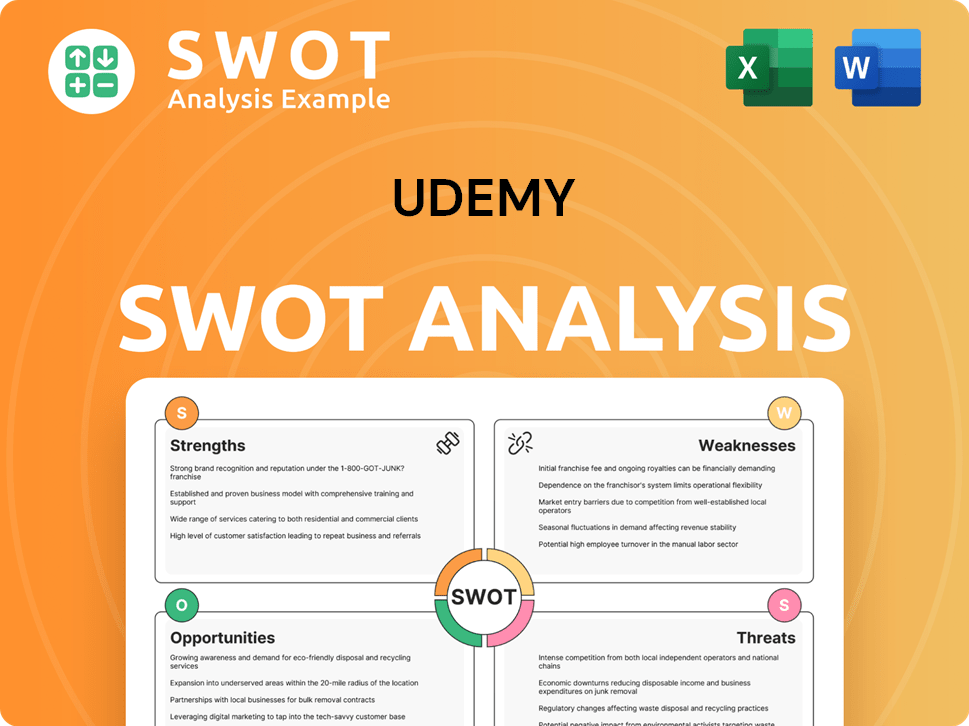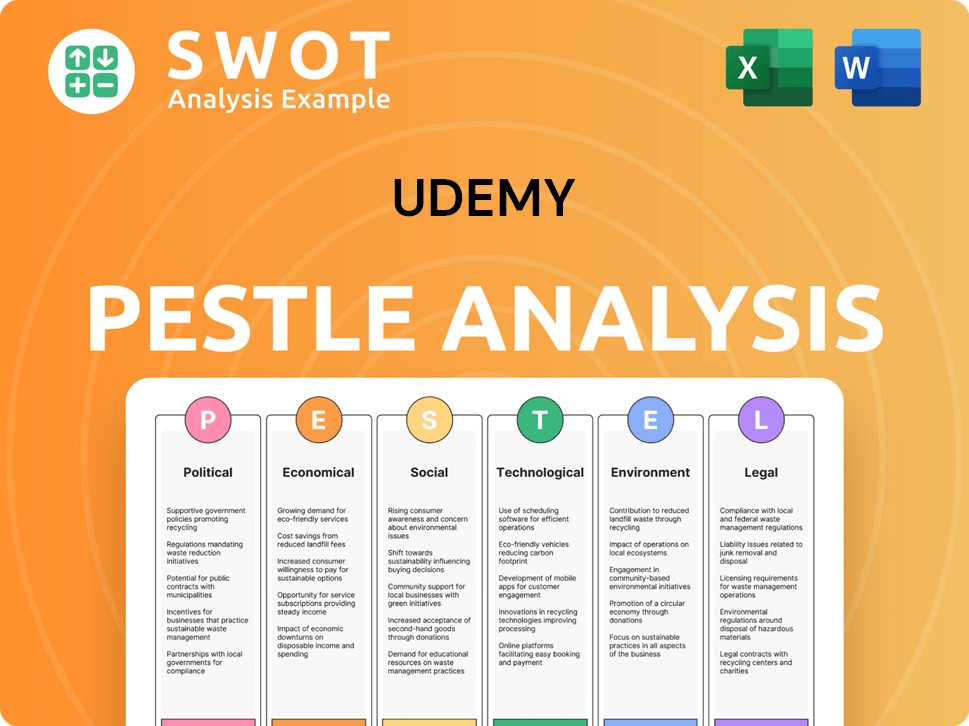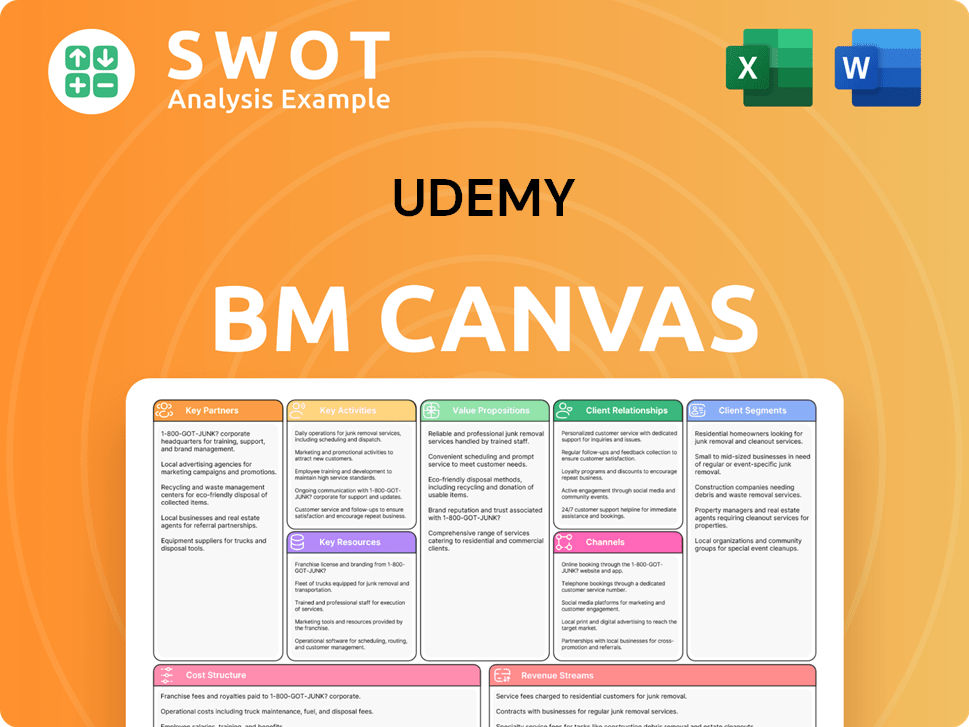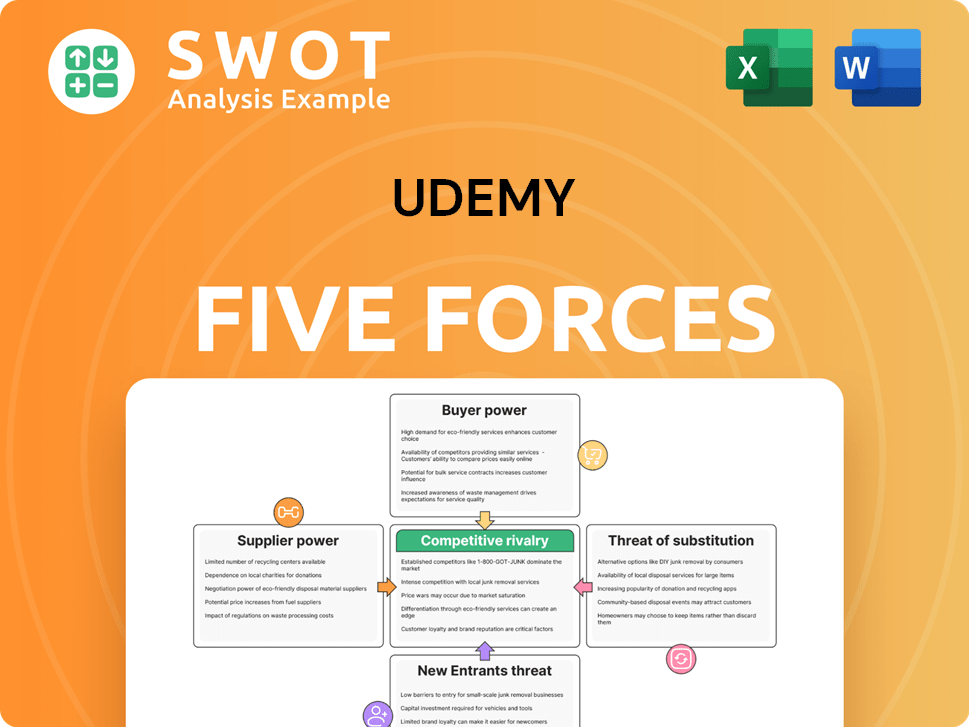Udemy Bundle
How Does Udemy Stack Up in the E-Learning Arena?
Udemy has revolutionized access to education, connecting learners with instructors worldwide. Launched in 2010, it aimed to democratize learning, offering a vast marketplace for courses. With millions of learners and a massive course catalog, Udemy's impact on the Udemy SWOT Analysis is undeniable.

Understanding the Udemy competitive landscape is crucial in today's dynamic e-learning industry. This analysis delves into Udemy competitors, exploring its Udemy business model, and providing a comprehensive Udemy market analysis. We'll examine its strengths and weaknesses, assessing its position against rivals like Coursera and Skillshare, and exploring its growth strategy.
Where Does Udemy’ Stand in the Current Market?
The company maintains a strong market position in the online learning industry, recognized as a leading platform with a significant global presence. Its core operations revolve around a vast consumer marketplace offering diverse subjects and the Udemy Business (UB) segment, which provides learning solutions to companies and organizations. This dual approach allows the company to cater to both individual learners and corporate clients, driving its market share and revenue streams.
Its value proposition lies in providing accessible, affordable, and diverse online courses. The platform connects instructors with learners worldwide, offering a wide array of courses across various topics, including technology, business, design, and personal development. This extensive course catalog and flexible learning model make it a popular choice for individuals and businesses seeking to upskill or reskill their employees.
The company has a substantial global reach, operating in over 190 countries. It has a significant user base in key markets such as the United States, India, Brazil, Mexico, and Turkey. This widespread presence underscores its ability to attract learners from diverse backgrounds and geographies.
Over time, the company has strategically shifted its focus towards enterprise growth. In 2024, the Enterprise segment accounted for 63% of total revenue, a significant increase from 18% in 2019. The long-term target is for Udemy Business to contribute 75% of total revenue.
The company reported total revenue of $786.6 million in 2024, representing an 8% year-over-year increase. The Enterprise segment's revenue grew by 18% to $494.5 million in 2024, with its Annual Recurring Revenue (ARR) reaching $516.9 million, an 11% year-over-year increase.
For the full year 2025, the company projects revenue between $787 million and $803 million, with Adjusted EBITDA between $75 million and $85 million. As of the end of 2024, the company held $355.7 million in cash, cash equivalents, restricted cash, and marketable securities.
The company's strategic focus on the enterprise segment, coupled with its global reach and diverse course offerings, positions it as a key player in the e-learning industry. The company's ability to adapt to market trends and expand its enterprise solutions will be critical for its continued growth. To gain deeper insights into the company's competitive landscape, you can explore a detailed analysis of the company's position in the market. For instance, a comparison like the one in this article about the company's competitors can provide a comprehensive understanding of its strengths and weaknesses.
The company's market position is supported by several key metrics that reflect its scale and financial performance.
- By the end of 2024, the company had 77 million learners and 17,096 enterprise customers.
- Total revenue in 2024 was $786.6 million, an 8% year-over-year increase.
- The Enterprise segment's revenue grew by 18% to $494.5 million in 2024.
- The company projects revenue between $787 million and $803 million for the full year 2025.
Udemy SWOT Analysis
- Complete SWOT Breakdown
- Fully Customizable
- Editable in Excel & Word
- Professional Formatting
- Investor-Ready Format

Who Are the Main Competitors Challenging Udemy?
The Growth Strategy of Udemy involves navigating a complex Udemy competitive landscape. The platform faces competition from various Udemy competitors, each vying for market share within the rapidly expanding e-learning industry. Understanding this competitive environment is crucial for assessing Udemy's position and future prospects.
The Udemy market analysis reveals a dynamic environment where platforms constantly evolve their offerings and strategies. This analysis must consider both direct and indirect competitors, as well as the broader trends shaping the online education sector. The e-learning market's projected growth, set to reach $1 trillion by 2028, highlights the significant opportunities and challenges within this space.
Udemy's business model is centered on providing a marketplace for online courses, which means it's constantly challenged by rivals. This includes platforms that offer similar content and those that specialize in particular areas or use different pricing models. The competitive landscape is further complicated by the entrance of new players and the emergence of innovative business strategies.
Direct competitors offer similar services to Udemy, focusing on professional development and skill enhancement. These platforms often compete on course offerings, pricing, and user experience. Understanding these direct competitors is essential for evaluating Udemy's strengths and weaknesses.
Coursera is a significant competitor, particularly due to its partnerships with universities and institutions. These collaborations allow Coursera to offer accredited courses and specializations. This focus on academic credibility provides a different value proposition compared to Udemy.
LinkedIn Learning leverages its professional networking platform to offer courses focused on business, technology, and creative skills. Integration with career development tools is a key differentiator. This integration provides a strong value proposition for professionals seeking career advancement.
Skillshare emphasizes creative skills and operates on a subscription-based model. This model differs from Udemy's marketplace approach, offering a different pricing structure and content focus. Skillshare's subscription model may appeal to users seeking continuous learning in creative fields.
Indirect competitors include platforms and providers that offer alternative learning experiences or target different segments of the market. These competitors may not directly compete with Udemy's core offerings but still impact its market share. Understanding these competitors provides a broader view of the competitive landscape.
Udemy's strategic pivot towards its enterprise segment, Udemy Business, positions it against corporate training providers. These providers offer customized training solutions for businesses. This shift expands Udemy's competitive landscape to include B2B learning solutions.
To succeed in this competitive environment, Udemy must leverage its strengths and adapt its strategies. This involves differentiating its offerings, optimizing its pricing, and forming strategic partnerships. Understanding these factors is crucial for assessing Udemy's long-term viability.
- Pricing and Value: Udemy's pricing structure, often featuring discounts and promotions, can be a key differentiator. However, the value proposition must be clear to attract and retain users.
- Content Differentiation: Offering a wide range of courses and focusing on high-demand topics is critical. This includes ensuring course quality and relevance to meet user needs.
- Partnerships and Collaborations: Forming partnerships with educational institutions and businesses can expand Udemy's reach and credibility. These collaborations can provide access to new markets and resources.
- Market Expansion: Expanding into new markets and segments, such as the enterprise market, is essential for growth. This includes adapting offerings to meet the needs of different user groups.
- Technological Advancements: Leveraging technology to improve the learning experience, such as through personalized learning paths and interactive content, can enhance user engagement.
Udemy PESTLE Analysis
- Covers All 6 PESTLE Categories
- No Research Needed – Save Hours of Work
- Built by Experts, Trusted by Consultants
- Instant Download, Ready to Use
- 100% Editable, Fully Customizable

What Gives Udemy a Competitive Edge Over Its Rivals?
The competitive landscape for online learning platforms is dynamic, with several key players vying for market share. Understanding the competitive advantages of each platform is crucial for investors, businesses, and learners. This analysis focuses on the strengths that position the company in the e-learning industry, considering its business model, market analysis, and strategic initiatives.
The company's success is built on a foundation of key milestones and strategic moves. The company has grown significantly since its inception, expanding its course offerings and user base. Strategic partnerships and technological advancements, such as AI-driven features, have further solidified its position in the market. This evolution reflects a commitment to adapting to the changing needs of learners and businesses alike, providing a competitive edge in the online learning space.
The company's competitive edge stems from its unique marketplace model, vast course library, and focus on affordability. These factors, combined with its global reach and technological innovations, contribute to its strong market position. The company's ability to connect instructors with learners, offer a wide range of courses, and provide accessible education sets it apart in the competitive landscape of online learning platforms.
The company operates a two-sided marketplace, connecting instructors and learners globally. This model fosters a flywheel effect, encouraging content creation and attracting users. This approach allows for rapid content updates and relevance, crucial in a fast-evolving market. The company's business model facilitates quick adaptation to market changes, such as the demand for remote work skills.
The platform boasts a vast library of approximately 250,000 courses, covering diverse topics. This wide range caters to various interests and skill levels, making it a comprehensive learning destination. This extensive library is a key differentiator, attracting a broad audience seeking a 'one-stop-shop' for education.
The company's pricing model, often featuring sales and discounts, makes quality education accessible. Lifetime access to purchased courses provides a significant advantage over subscription-based models. This affordability strategy broadens its appeal, attracting a diverse user base seeking value for their investment.
The platform leverages AI and machine learning to enhance the learning experience. Features like the AI Assistant and Skills Mapping personalize course recommendations. These technological advancements drive growth and performance, particularly for enterprise clients. The company's focus on technology ensures its offerings remain relevant and engaging.
The company's competitive advantages are multifaceted, encompassing its marketplace model, course offerings, and technological integration. This model allows for rapid content updates and relevance, crucial in a fast-evolving market. The company's global reach and diverse course offerings cater to a wide audience.
- Marketplace Model: Connects instructors and learners globally, fostering content creation.
- Extensive Course Library: Offers approximately 250,000 courses across various topics.
- Affordable Pricing: Provides accessible education through sales and discounts.
- Technological Integration: Uses AI to personalize learning and improve the user experience.
- Global Reach: Services available in 75 languages, supporting over 17,000 enterprise customers.
Udemy Business Model Canvas
- Complete 9-Block Business Model Canvas
- Effortlessly Communicate Your Business Strategy
- Investor-Ready BMC Format
- 100% Editable and Customizable
- Clear and Structured Layout

What Industry Trends Are Reshaping Udemy’s Competitive Landscape?
The online learning industry is experiencing significant growth, fueled by technology and changing consumer needs. This shift includes a rise in remote work and a focus on skill-based learning. Artificial intelligence (AI) is also playing a major role, with personalized learning and real-time feedback becoming more common, which is something the company is currently implementing with its AI Assistant and Skills Mapping solutions.
However, the company faces challenges such as intense competition and maintaining course quality. The consumer segment saw a 5% revenue decline in 2024, and a recent analyst downgrade in April 2025 highlighted investor concerns. Despite these hurdles, opportunities exist in global expansion and corporate partnerships.
The e-learning industry is moving towards online learning and skill-based training. AI is transforming the sector by enabling personalized recommendations and adaptive learning. The rise of remote work is also contributing to the growth of online education.
Intense competition from established and emerging players poses a significant challenge. Maintaining course quality and adapting to technological changes are ongoing concerns. The consumer segment's decline in revenue, coupled with investor skepticism, creates additional pressure.
Global expansion into new international markets presents a key opportunity. Partnerships with corporations for customized training programs offer a lucrative avenue. Leveraging data analytics and investing in AI can enhance user experience and engagement.
The company is pivoting towards the enterprise segment, aiming for it to contribute 75% of total revenue. Strategies include investing in AI, deepening relationships with enterprise customers, and increasing operational efficiency. The focus on enterprise solutions is crucial for long-term growth.
The company is focusing on its enterprise solutions and enhancing AI-driven learning experiences to maintain its competitive edge. Strategic partnerships, such as the one with Indeed, are also vital for growth. To understand the overall strategy, consider reading about the Marketing Strategy of Udemy.
- Focus on enterprise solutions to drive revenue growth.
- Leverage AI for personalized learning experiences.
- Expand into new international markets.
- Form strategic partnerships to enhance offerings.
Udemy Porter's Five Forces Analysis
- Covers All 5 Competitive Forces in Detail
- Structured for Consultants, Students, and Founders
- 100% Editable in Microsoft Word & Excel
- Instant Digital Download – Use Immediately
- Compatible with Mac & PC – Fully Unlocked

Related Blogs
- What are Mission Vision & Core Values of Udemy Company?
- What is Growth Strategy and Future Prospects of Udemy Company?
- How Does Udemy Company Work?
- What is Sales and Marketing Strategy of Udemy Company?
- What is Brief History of Udemy Company?
- Who Owns Udemy Company?
- What is Customer Demographics and Target Market of Udemy Company?
Disclaimer
All information, articles, and product details provided on this website are for general informational and educational purposes only. We do not claim any ownership over, nor do we intend to infringe upon, any trademarks, copyrights, logos, brand names, or other intellectual property mentioned or depicted on this site. Such intellectual property remains the property of its respective owners, and any references here are made solely for identification or informational purposes, without implying any affiliation, endorsement, or partnership.
We make no representations or warranties, express or implied, regarding the accuracy, completeness, or suitability of any content or products presented. Nothing on this website should be construed as legal, tax, investment, financial, medical, or other professional advice. In addition, no part of this site—including articles or product references—constitutes a solicitation, recommendation, endorsement, advertisement, or offer to buy or sell any securities, franchises, or other financial instruments, particularly in jurisdictions where such activity would be unlawful.
All content is of a general nature and may not address the specific circumstances of any individual or entity. It is not a substitute for professional advice or services. Any actions you take based on the information provided here are strictly at your own risk. You accept full responsibility for any decisions or outcomes arising from your use of this website and agree to release us from any liability in connection with your use of, or reliance upon, the content or products found herein.